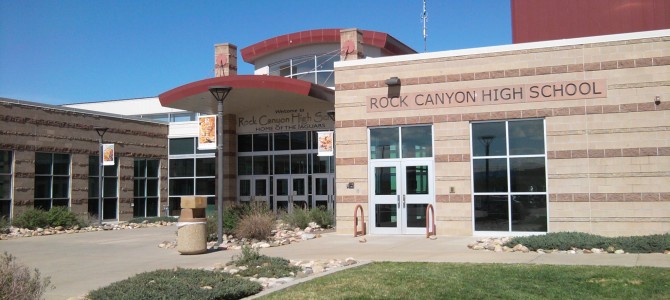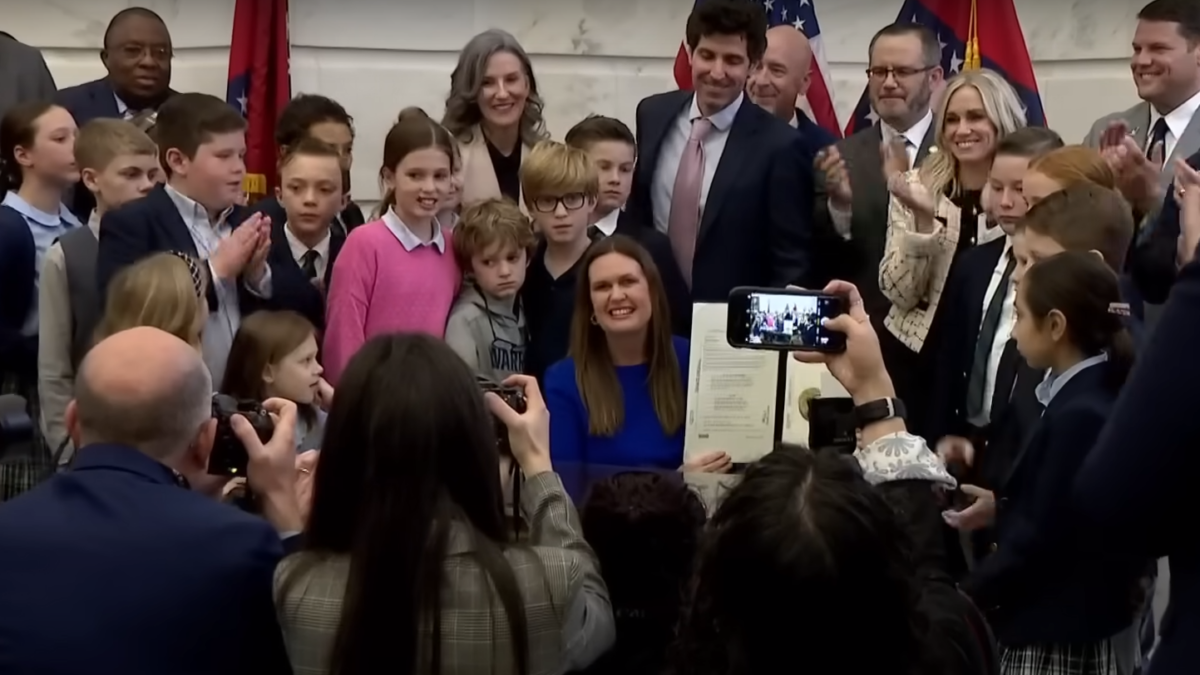
Karin Piper wasn’t aiming to bust a union when she asked her Douglas County, Colorado school board to hold contract negotiations in public. Back in 2012, the mother of three was just tired of all the gossip flying around Facebook and play groups.
“If you had questions about what happening behind closed doors, then you didn’t like teachers,” Piper said. “It was really difficult to ferret out who was speaking the truth.”
The local teachers union contract was then about to expire. After a conservative school board majority that had arrived in 2009 was re-elected in 2011, the union was getting antsy about agenda items that included the nation’s first district-run vouchers program, paying teachers market rates, and refusing to turn over taxpayer dollars for the union’s political activities.
In 2012, “I was up a lot at night,” said Douglas County Superintendent Liz Fagen, whom the board hired to put their trailblazing ideas into action. Piper says some desperados even publicly noted which school Fagen’s child attended—implying a threat to her safety.
When 300 blue-shirt-wearing union members showed up at a board meeting chanting “This is what democracy looks like” and complaining vouchers and merit pay would “starve public education,” the four conservative board members began to consider dropping the union contract entirely. But open negotiations made that crazy-seeming idea a reality. It led to public discoveries that union money and activity in Douglas County—as everywhere else—went more to political activities than instructional improvements. Once that happened, the board began to consider, and then follow through on, ending its union contract.
“What we have been able to do and the speed at which we have been able to do it directly results from not having a union contract, because with a union everything is a compromise position,” says Fagen, a quick-speaking mother of two who looks to be about five feet, two inches tall.
Once free of the union, Douglas County could experiment with free-market ideas that most conservative school board members—where they exist—only dream about. If its experiments go well, it offers a template both for propelling conservatives into education, which is largely a liberal playground even in K-12, and for what such leaders might do when they get there.
Supply And Demand: A Novel Concept for Teachers
DougCo has gotten the most national attention for proposing the nation’s first district-run vouchers program (it’s on hold, awaiting a Colorado Supreme Court ruling this fall), but Fagen said choosing to pay teachers market rates has been far more internally divisive.
The research demonstrating a teacher’s importance has only compounded. Teaching quality is the single most important factor a school controls that affects children, for better or for worse. A widely noted 2012 study that tracked 2.5 million children over 20 years found that teacher quality affects teen pregnancy rates, student achievement, and kids’ lifetime earnings. Replacing a poor teacher with just an average one would raise a classroom of students’ lifetime earnings by approximately $266,000. Economist Eric Hanushek has estimated that replacing the worst 5 to 7 percent of teachers with merely average-quality teachers would increase U.S. economic output by $112 trillion—yes, trillion with a T—over the lifetimes of the rising generation. It is almost impossible to fathom the worldwide benefits, which extend far beyond economic improvements.
Despite the massive consequences of hiring top teachers, almost no school district pays teachers according to quality or its need for particular skills. They typically pay according to union-preferred criteria known as “step-and-lane,” where two factors determine pay: The number of years a teacher has worked in the school district, and the number of credentials she has amassed. This pay scale is at the heart of two lawsuits raging in California and New York, which claim—correctly—that it sends the worst teachers to the lowest-performing students in poor communities who need good teachers most.
Only governments hire without regard to employee performance, because businesses that face competition can’t afford to. When he worked in the private sector, for companies such as Microsoft and General Electric, DougCo schools’ human resources director Brian Cesare could look at Labor Department data or gossip with colleagues to triangulate the going rates for certain positions. When he came to Douglas County, he couldn’t do that. No one had any idea what the market rate was for a school speech therapist. There was no market.
Given the sheer number of people public schools employ, that’s an amazing statement. At 63,000 students and 7,000 employees, Douglas County is Colorado’s third-largest school district. Like many other districts, it the largest local employer. If it were a business, Douglas County would be in a category with the biggest 0.007 percent of U.S. employers, if one calculates using Census Bureau data.
Self-Worth Versus Market Value
Seated at a conference table in Fagen’s office, Cesare ran his finger down a chart, noting that Douglas County hires for 72 distinct positions, and all require different training and skills, yet its union contract forbade recognizing that reality when attracting applicants. Open positions for elementary ed were always flooded with applicants, but school principals were lucky to get one applicant for a special-education opening.
This severely hampered DougCo’s ability to find quality teachers. For one, a pay schedule means that people who make more than they’re worth are less likely to move on because they can’t get a better offer anywhere else. Conversely, people who earn less than they’re worth are more likely to move.
Further, bright college students have many career options. Fagan, who was once a pre-med student and graduated with a chemistry major, knows their dilemma: “I could earn $55,000 from [global agriculture conglomerate] Cargill starting out, or $31,000 as a teacher, where I would have to choose between buying a microwave and a vacuum.”
Since there was no market data available, Cesare tried to triangulate using what else he could find. He started calling principals and asking them to rank their job openings, from easiest-to-fill positions to hardest. In 2012, Douglas County unveiled a new pay scale with five salary ranges, or “bands.” Each of the district’s 72 positions fit into one band. In the bottom pay bracket were positions such as second- through fifth-grade teachers and physical education teachers. They can earn between $32,000 and $60,000 annually in base pay (which doesn’t include performance bonuses). The top bracket includes speech pathologists and school psychologists. They can earn between $45,000 and $94,000 in base pay.
2012 was the first year Douglas County had more applicants than special education positions. The next year, the district had enough information to expand the pay scale to six bands. Cesare thinks they can soon field ten.
New teachers now start off at the bottom of the range for their job title, and as they demonstrate student achievement and meet other professional goals, they can earn more. Existing employees received no salary cut, but get different annual raises that gradually on- or off-ramp them into the designated salary range for their position and job performance. Someone already earning too much for her job title and performance might get consecutive 1 percent annual raises, while someone earning too little for her job title and performance could get annual pay raises of as much as 8 percent or more.This, even more than dropping the union contract or starting a voucher program, made her district explode, Fagen says.
“People in general associate their self-worth with what they make,” she noted. The district had to field hundreds of angry teachers offended at receiving a label suggesting their work was worth less money than that of the teacher in the next classroom. The year the new pay scale was implemented, approximately 13 percent of teachers left the district, which was nearly 100 more teachers than had left the previous year. The next year, 2013, 380 teachers left, or nearly 12 percent. All these are still below the statewide teacher turnover rate, which was 17 percent in 2013, according to the Colorado Department of Education.
Return of The Union
The tumult also gave an opening for the spurned union local to mount a divisive campaign against the district’s four conservative school board members. It backed four challengers for their positions and started throwing up placards and legal complaints. There was even a documentary film. The accusations ran the gamut, from screeds against “corporate reform,” which stem from union antipathy to market forces, to “how can you value one kind of teacher over another? Isn’t my kindergarten teacher as valuable as your math teacher?” said Ben DeGrow, an education policy analyst at the Denver-based Independence Institute. “They don’t understand economics, but the emotion appealed to the soccer moms.”

The union was on a trajectory to boot the conservative school board members from their posts until a right-wing community organizer and other Republican supporters mobilized to respond.
“Our side has a lot to learn about political messaging,” DeGrow says. “It’s not just in the message, but in the method. Our side is all too comfortable with the air war—I’ll use a military term. We use TV ads or radio ads, but the community organizer theory of people touching people and relationships, there’s a lot of power in that.”
Putting boots on the ground, to use another military metaphor, made a difference. Damon Sasso, the community organizer, who also works for a northern Colorado radio station, made shareable YouTube videos, acted as a buffer between the various pro-reform political groups, and helped organize “house parties,” where a local resident, usually a suburban mom, invited her friends to her house for a Q&A with a school board candidate and snacks. Conservatives also hired college kids to knock on thousands of doors in the suburbs, surveying residents about education policy. Areas that leaned pro-market were targeted with get-out-the-vote efforts. DeGrow says the target areas had turnout of 88 percent. In Douglas County overall, turnout was about 48 percent. Both are higher than average, but 88 percent is astronomical.
“A lot of my job was managing the relationships between people,” Sasso said, talking on his cell as he pumped gas. “There was a lot of internal bickering of ‘this person didn’t like this because of that.’ I tried to zoom out and say, ‘We may not all agree on tactics, but we all want the same thing.’”
When Sasso took his show on the road, he didn’t want to be “dreadfully boring” like other political booths at fairs and other expos. So the Douglas County Champs for Kids group he helped organize put up a “Wheel of Choice,” where if the spinner landed on one of the board’s main education policies the guest could pick his own candy from a bowl, but if the spinner landed on “status quo stuff” the booth monitor would pick the candy for the spinner.
“This is a personal opinion,” Sasso said: “Those I find on the Left are very emotional and if they have a weak argument they tend to go into personal attacks very quickly. We made an agreement that we were always going to talk about the issues passionately but we were never going to attack personally. So an outsider on the fence would see that if they were watching…We wanted the reform side to be the people you wanted to have a drink with.”
As the conservatives gained traction, their opponents got more desperate, and then “more insane,” Sasso said. That’s when the rhetoric started to get unhinged—such as saying a certain candidate “hates kids,” for example.
“The people in our group who knew [bystanders to these arguments] best would reach out and say, ‘I know you care about kids and schools, and you don’t want bullies running the district,’” Sasso said.
When he met people passionate about a certain strategy or idea, he asked them to lead an effort to carry it out. One mother suggested putting up a TV with good news about the district outside a screening of an anti-district documentary. Sasso got her a little money, she got it built, and she and her friends stood outside the screening next to the TV cart, handing out flyers.
“Conservatives get into this bad habit, assuming that people think like we do and relationships aren’t a big deal,” Sasso said. “You can’t ignore the power of a face-to-face interaction.”
The most effective thing Sasso did, he says, is to build relationships and trust with people living in Douglas County. That required him to spend hours on living room and cell-phone conversations, and functioning as the go-between when people got on each other’s nerves. It required him to take people’s objections and concerns seriously. Mostly, he says, what he did was listen.
The 2013 Douglas County election results were not razor-thin, but not a blowout, either. The margin of victory in each of the four hotly contested races was about 3,000 votes, or a four-point spread. But all the board members who had faced a heavy barrage of union fire maintained their seats. As Wisconsin Gov. Scott Walker knows, that’s not a small victory.
An Idea with Growth Potential
Sasso has started taking what he’s learned in Douglas County into other school board races. He agreed with the district’s leaders, who emitted a chorus of “no’s” when asked over lunch at a Castle Rock pizzeria if school board elections were really as nonpartisan as politicos like to claim education politics should be.
“Everything’s peaceful and going along great until you put a conservative-minded reformer into a school district, and all of a sudden Chicago-style politics comes into these little towns,” Sasso said, chuckling.
The world of education tilts heavily Left, and transmits and heightens that tilt to each subsequent generation. But when a little tribe of conservatives actually puts up a fight in local politics, Douglas County shows it can make a real difference. And not just in their town, although there is that. Thanks to the boots on the ground that rescued their campaigns, Douglas County school leaders are now free to uproot a collectivist system that treats teachers and kids like interchangeable machine parts.
“If this could ripple, it could benefit the country,” Cesare says of the district’s teacher pay revamp. Paying quality teachers more would increase the applicant pool not just in Douglas County, but everywhere, by attracting some smart pre-law, chemistry, and math majors from their other lucrative options into education.
Cesare travels regularly to explain to other districts what Douglas County is doing with teacher pay. If DougCo’s experiment works out, he says, others will follow suit. If they do, it will affect education schools, which are notorious for jettisoning academics in favor of leftist activism, to an even greater extent than most of higher education. Research has shown education majors typically have among the lowest SAT and GRE scores and worst academic records of all college students. But education schools make colleges a lot of money, so they don’t want to close them, and school districts don’t have the information to demand better graduates, so there’s little pressure to improve.
Cesare is working on a data system connected to the district’s teacher performance ratings to boost his recruiting. It is amassing information about which teachers from which schools and even ZIP codes perform better than others, down to the micro-level such as how their principals rate them on specific teaching techniques and their students’ test performance on specific topics.
In the meantime, “our kids will get the better teacher in front of them,” he said. “If you get a bad teacher two years in a row, you never recover.” A secondary effect would change the culture of education. Currently, Cesare says, school districts have teacher absentee rates of 8 percent, which is two times the national average of private-sector absenteeism. Over a child’s 12 years of secondary and elementary education, that equates to a full year with a substitute teacher. Research finds what parents already know: kids learn far less with subs.
Teachers typically don’t go into education for the money, as Fagan knows from her own choices, but pay does signal what work provides society the best return on a person’s time and energies. A bigger return for a certain career indicates a bigger societal need for it. A bigger return in exchange for more effort also helps people decide against the path of least resistance, so they overcome a natural desire for comfort to choose a career that helps society more. That’s how markets work. Fagan’s goal, and Douglas County’s, is to work with people’s natural inclinations, rather than against them, to give their students the best teachers they can.









